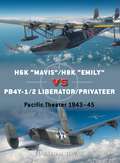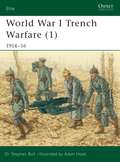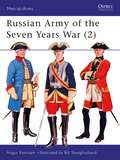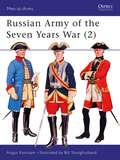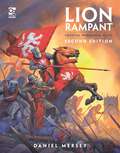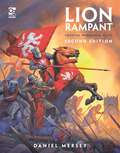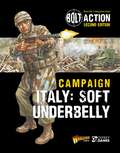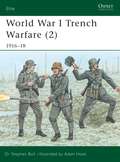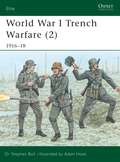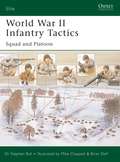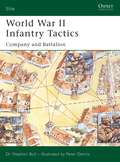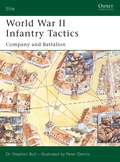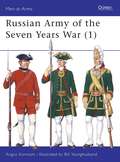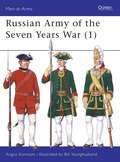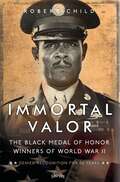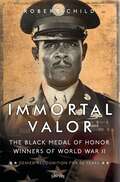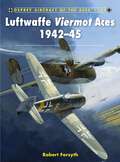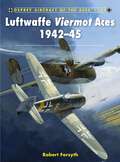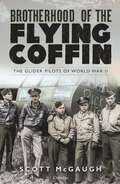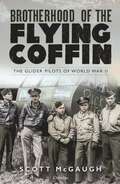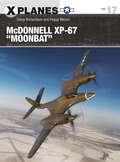- Table View
- List View
H6K “Mavis”/H8K “Emily” vs PB4Y-1/2 Liberator/Privateer: Pacific Theater 1943–45 (Duel)
by Edward M. YoungAn illustrated exploration of the dramatic aerial combats between the US Navy's long-range bomber and Japanese flying boats in the Pacific War.Edward Young explores these rarely written about combats, examining the aggressive and strategic tactics deployed by both US Navy and Imperial Japanese Navy Air Force and analyzing the technical improvements installed throughout the war.The PB4Y-1/2 Liberator/Privateer was the US Navy's first four-engined, land-based bomber, adapted and allocated to fight the U-boat menace in the Atlantic and protect the vast reaches of the Pacific Ocean. The long range, speed, armament and bomb load of the PB4Y-1 enabled the US Navy's Pacific squadrons to adopt more aggressive tactics. The PB4Y-1, and its follow-on PB4Y-2, engaged in dangerous bombing missions against Japanese installations, shipping strikes, and air combat. On the other side, with its doctrine of making the first strike against an enemy fleet, the Imperial Japanese Navy recognized the vital importance of maritime reconnaissance, relying on carrier-based reconnaissance aircraft, ship-borne floatplanes and, for long-range maritime patrol, flying boats. The Japanese would continue to develop their aircraft throughout the war, resulting, among others, in the H6K 'Mavis' and the H8K2 'Emily', which despite never achieving a victory, was regarded by the Allied pilots as the most difficult Japanese aircraft to destroy. Enriched with specially commissioned artwork, including armament and cockpit views, battlescenes and technical diagrams, this title analyses technical specifications in detail. By including first-hand accounts, aviation expert Edward Young provides a detailed account of these one-sided yet dramatic and aggressive combats.
World War I Trench Warfare: 1914–16 (Elite)
by Stephen BullThe regular armies which marched off to war in 1914 were composed of massed riflemen, screened by cavalry and supported by artillery; their leaders expected a quick and decisive outcome, achieved by sweeping manoeuvre, bold leadership and skill at arms. Eighteen months later the whole nature of field armies and their tactics had changed utterly. In sophisticated trench systems forming a battlefield a few miles wide and 400 miles long, conscript armies sheltered from massive long-range bombardment, wielding new weapons according to new tactical doctrines. This first of two richly illustrated studies explains in detail the specifics of that extraordinary transformation, complete with ten full colour plates of uniforms and equipment.
World War I Trench Warfare: 1914–16 (Elite)
by Stephen BullThe regular armies which marched off to war in 1914 were composed of massed riflemen, screened by cavalry and supported by artillery; their leaders expected a quick and decisive outcome, achieved by sweeping manoeuvre, bold leadership and skill at arms. Eighteen months later the whole nature of field armies and their tactics had changed utterly. In sophisticated trench systems forming a battlefield a few miles wide and 400 miles long, conscript armies sheltered from massive long-range bombardment, wielding new weapons according to new tactical doctrines. This first of two richly illustrated studies explains in detail the specifics of that extraordinary transformation, complete with ten full colour plates of uniforms and equipment.
Russian Army of the Seven Years War (Men-at-Arms)
by Angus KonstamThis second volume (see MAA 297) by Angus Konstam on the Russian Army of the Seven Years War concentrates on the cavalry, both the regular troops and irregular forces, considering their composition, nature and effectiveness. It also outlines the state of the Russian train of artillery, which was seen as the premier branch of the army and dominated Russian military doctrine throughout the 18th century. As a result of reforms to the, the Russians entered the war with Prussia somewhat wrong footed. The ability of the army to recover from this in the crucible of war is a major part of this story.
Russian Army of the Seven Years War (Men-at-Arms)
by Angus KonstamThis second volume (see MAA 297) by Angus Konstam on the Russian Army of the Seven Years War concentrates on the cavalry, both the regular troops and irregular forces, considering their composition, nature and effectiveness. It also outlines the state of the Russian train of artillery, which was seen as the premier branch of the army and dominated Russian military doctrine throughout the 18th century. As a result of reforms to the, the Russians entered the war with Prussia somewhat wrong footed. The ability of the army to recover from this in the crucible of war is a major part of this story.
Lion Rampant: Medieval Wargaming Rules
by Daniel MerseyAn expanded edition of the Origins Award-nominated Lion Rampant, featuring new rules, scenarios, and sample armies.Take to the battlefield as Richard the Lionheart, Joan of Arc or William Wallace – or forge your own legend – with Lion Rampant: Second Edition. From the Dark Ages to the Hundred Years' War, raids, skirmishes, and clashes between small retinues were a crucial part of warfare, and these dramatic small-scale battles are at the heart of this easy-to-learn but tactically rewarding wargame. Lion Rampant: Second Edition is a new, updated version of the hit Osprey Wargames series title, and retains the core gameplay while also incorporating a wealth of new rules and updates from several years' worth of player feedback and development. Whether they are looking to recreate historical encounters or tell their own stories, the varied scenarios, unit types, and sample retinue lists found in this volume provide everything players need to face each other in quick, exciting, and, above all, fun tabletop battles.
Lion Rampant: Medieval Wargaming Rules
by Daniel MerseyAn expanded edition of the Origins Award-nominated Lion Rampant, featuring new rules, scenarios, and sample armies.Take to the battlefield as Richard the Lionheart, Joan of Arc or William Wallace – or forge your own legend – with Lion Rampant: Second Edition. From the Dark Ages to the Hundred Years' War, raids, skirmishes, and clashes between small retinues were a crucial part of warfare, and these dramatic small-scale battles are at the heart of this easy-to-learn but tactically rewarding wargame. Lion Rampant: Second Edition is a new, updated version of the hit Osprey Wargames series title, and retains the core gameplay while also incorporating a wealth of new rules and updates from several years' worth of player feedback and development. Whether they are looking to recreate historical encounters or tell their own stories, the varied scenarios, unit types, and sample retinue lists found in this volume provide everything players need to face each other in quick, exciting, and, above all, fun tabletop battles.
Bolt Action: Campaign: Italy: Soft Underbelly (Bolt Action)
by Warlord GamesWith the Axis Powers ejected from North Africa, the Western Allies look to take the fight across the Mediterranean and into Mussolini's Italy. This supplement for Bolt Action focuses on Operation Husky, the airborne and naval invasion of Sicily, the hard-fought battles in the villages and rugged mountain passes of that island, and the advance up the Italian Peninsula towards Rome. With a host of scenarios, new units, special rules, and Theatre Selectors this book contains everything players need to refight these important battles in defence of the Regno d'Italia or to strike at the underbelly of Axis-controlled Europe.
Bolt Action: Campaign: Italy: Soft Underbelly (Bolt Action)
by Warlord GamesWith the Axis Powers ejected from North Africa, the Western Allies look to take the fight across the Mediterranean and into Mussolini's Italy. This supplement for Bolt Action focuses on Operation Husky, the airborne and naval invasion of Sicily, the hard-fought battles in the villages and rugged mountain passes of that island, and the advance up the Italian Peninsula towards Rome. With a host of scenarios, new units, special rules, and Theatre Selectors this book contains everything players need to refight these important battles in defence of the Regno d'Italia or to strike at the underbelly of Axis-controlled Europe.
World War I Trench Warfare: 1916–18 (Elite)
by Stephen BullThe Allied attempt to break the stalemate of trench warfare by the 'big pushes' of 1916 led to massively costly battles of attrition. The Germans responded by developing schemes of defence in depth anchored on concrete bunkers; the Allies, by sophisticated artillery tactics in support of infantry assaults, and by the introduction of the tank - at first an accident-prone novelty, but later a front-breaking weapon. On both sides the small, self-reliant, opportunistic infantry unit, with its own specialist weapons, became the basic tool of attack. This second of a fascinating two-part study of the birth of 20th century tactics is illustrated in colour and includes rare photographs.
World War I Trench Warfare: 1916–18 (Elite)
by Stephen BullThe Allied attempt to break the stalemate of trench warfare by the 'big pushes' of 1916 led to massively costly battles of attrition. The Germans responded by developing schemes of defence in depth anchored on concrete bunkers; the Allies, by sophisticated artillery tactics in support of infantry assaults, and by the introduction of the tank - at first an accident-prone novelty, but later a front-breaking weapon. On both sides the small, self-reliant, opportunistic infantry unit, with its own specialist weapons, became the basic tool of attack. This second of a fascinating two-part study of the birth of 20th century tactics is illustrated in colour and includes rare photographs.
World War II Infantry Tactics: Squad and Platoon (Elite)
by Stephen BullDespite all technological advances, final mastery of any battlefield depends upon the tight-knit group of footsoldiers trained to manoeuvre, shoot and dig in. This first of a two-part study examines the methods by which the Western infantry of World War II - the German, British and US armies - actually brought their firepower to bear. Drawing upon period training manuals for the evolving theory, and on personal memoirs for the individual practice, this first book covers the organization and tactics of the squad of ten or a dozen men, and the platoon of three or four squads. The text is illustrated with contemporary photographs and diagrams, and with colour plates bringing to life the movement of soldiers on the battlefield.
World War II Infantry Tactics: Squad and Platoon (Elite)
by Stephen BullDespite all technological advances, final mastery of any battlefield depends upon the tight-knit group of footsoldiers trained to manoeuvre, shoot and dig in. This first of a two-part study examines the methods by which the Western infantry of World War II - the German, British and US armies - actually brought their firepower to bear. Drawing upon period training manuals for the evolving theory, and on personal memoirs for the individual practice, this first book covers the organization and tactics of the squad of ten or a dozen men, and the platoon of three or four squads. The text is illustrated with contemporary photographs and diagrams, and with colour plates bringing to life the movement of soldiers on the battlefield.
World War II Infantry Tactics: Company and Battalion (Elite)
by Stephen BullWorld War II is often seen as a confrontation of technology – tanks and aircraft, artillery and engineering. But at the heart of the battlefield was the struggle between infantrymen, and the technology was there to enable them to capture ground or hold it. This second of two books on the organization and tactics of the German, US and British infantry in Europe focuses on national differences in the development of company and battalion tactics – including those of motorized units – and the confrontation and co-operation between infantry and tanks. Contemporary photos and diagrams and vivid colour plates illustrate what tactical theories actually meant on the ground at human scale.
World War II Infantry Tactics: Company and Battalion (Elite)
by Stephen BullWorld War II is often seen as a confrontation of technology – tanks and aircraft, artillery and engineering. But at the heart of the battlefield was the struggle between infantrymen, and the technology was there to enable them to capture ground or hold it. This second of two books on the organization and tactics of the German, US and British infantry in Europe focuses on national differences in the development of company and battalion tactics – including those of motorized units – and the confrontation and co-operation between infantry and tanks. Contemporary photos and diagrams and vivid colour plates illustrate what tactical theories actually meant on the ground at human scale.
Russian Army of the Seven Years War (Men-at-Arms)
by Angus KonstamDuring the long and costly conflict known as the Great Northern War [1700-1721], Peter the Great and his newly formed Russian army, which was modelled on western European lines, defeated their Swedish counterparts, who were generally regarded as being the finest troops in Europe. Angus Konstam examines the development, equipment and organisation of the Russian army following the death of Peter the Great, and describes its emergence from three decades of experimentation and political involvement as a major military power during the Seven Years War. This first of two volumes covers the Russian infantry, with its companion, Men-at-Arms 298, focusing on the cavalry.
Russian Army of the Seven Years War (Men-at-Arms)
by Angus KonstamDuring the long and costly conflict known as the Great Northern War [1700-1721], Peter the Great and his newly formed Russian army, which was modelled on western European lines, defeated their Swedish counterparts, who were generally regarded as being the finest troops in Europe. Angus Konstam examines the development, equipment and organisation of the Russian army following the death of Peter the Great, and describes its emergence from three decades of experimentation and political involvement as a major military power during the Seven Years War. This first of two volumes covers the Russian infantry, with its companion, Men-at-Arms 298, focusing on the cavalry.
Immortal Valor: The Black Medal of Honor Winners of World War II
by Robert ChildThe remarkable story of the seven African American soldiers ultimately awarded the World War II Medal of Honor, and the 50-year campaign to deny them their recognition. In 1945, when Congress began reviewing the record of the most conspicuous acts of courage by American soldiers during World War II, they recommended awarding the Medal of Honor to 432 recipients. Despite the fact that more than one million African-Americans served, not a single black soldier received the Medal of Honor. The omission remained on the record for over four decades.But recent historical investigations have brought to light some of the extraordinary acts of valor performed by black soldiers during the war. Men like Vernon Baker, who single-handedly eliminated three enemy machineguns, an observation post, and a German dugout. Or Sergeant Reuben Rivers, who spearhead his tank unit's advance against fierce German resistance for three days despite being grievously wounded. Meanwhile Lieutenant Charles Thomas led his platoon to capture a strategically vital village on the Siegfried Line in 1944 despite losing half his men and suffering a number of wounds himself. Ultimately, in 1993 a US Army commission determined that seven men, including Baker, Rivers and Thomas, had been denied the Army's highest award simply due to racial discrimination. In 1997, more than 50 years after the war, President Clinton finally awarded the Medal of Honor to these seven heroes, sadly all but one of them posthumously. These are their stories.
Immortal Valor: The Black Medal of Honor Winners of World War II
by Robert ChildThe remarkable story of the seven African American soldiers ultimately awarded the World War II Medal of Honor, and the 50-year campaign to deny them their recognition. In 1945, when Congress began reviewing the record of the most conspicuous acts of courage by American soldiers during World War II, they recommended awarding the Medal of Honor to 432 recipients. Despite the fact that more than one million African-Americans served, not a single black soldier received the Medal of Honor. The omission remained on the record for over four decades.But recent historical investigations have brought to light some of the extraordinary acts of valor performed by black soldiers during the war. Men like Vernon Baker, who single-handedly eliminated three enemy machineguns, an observation post, and a German dugout. Or Sergeant Reuben Rivers, who spearhead his tank unit's advance against fierce German resistance for three days despite being grievously wounded. Meanwhile Lieutenant Charles Thomas led his platoon to capture a strategically vital village on the Siegfried Line in 1944 despite losing half his men and suffering a number of wounds himself. Ultimately, in 1993 a US Army commission determined that seven men, including Baker, Rivers and Thomas, had been denied the Army's highest award simply due to racial discrimination. In 1997, more than 50 years after the war, President Clinton finally awarded the Medal of Honor to these seven heroes, sadly all but one of them posthumously. These are their stories.
Luftwaffe Viermot Aces 1942–45 (Aircraft of the Aces)
by Robert ForsythA full account of the German airmen who achieved ace status by destroying Allied bombers.Viermot Aces' were pilots who shot down five or more USAAF and RAF bombers during the daylight Defence of the Reich missions from May 1942 through to VE Day. This book tells the complete story of the men and the planes that challenged the great bomber offensive. Flying a number of different aircraft including the Bf 110G, Me 210 and the Me 410, they fought their desperate battles against the numerous machine guns of B-17s and Lancasters. This book also covers the 'jet aces' that flew the Me 262 jet-powered interceptors in the closing days of the war to wage a desperate last-ditch fight against the endless Allied bomber fleets.
Luftwaffe Viermot Aces 1942–45 (Aircraft of the Aces)
by Robert ForsythA full account of the German airmen who achieved ace status by destroying Allied bombers.Viermot Aces' were pilots who shot down five or more USAAF and RAF bombers during the daylight Defence of the Reich missions from May 1942 through to VE Day. This book tells the complete story of the men and the planes that challenged the great bomber offensive. Flying a number of different aircraft including the Bf 110G, Me 210 and the Me 410, they fought their desperate battles against the numerous machine guns of B-17s and Lancasters. This book also covers the 'jet aces' that flew the Me 262 jet-powered interceptors in the closing days of the war to wage a desperate last-ditch fight against the endless Allied bomber fleets.
Brotherhood of the Flying Coffin: The Glider Pilots of World War II
by Scott McGaughThe first major history of the American glider pilots, the forgotten heroes of World War II, by New York Times bestselling author Scott McGaugh. A story of no guns, no engines and no second chances.This book distills war down to individual young men climbing into defenseless gliders made of plywood, ready to trust the towing aircraft that would pull them into enemy territory by a single cable wrapped with a telephone wire. Based on their after-action reports, journals, oral histories, photos and letters home, The Brotherhood of the Flying Coffin reveals every terrifying minute of their missions.They were all volunteers, for a specialized duty that their own government projected would have a 50 percent casualty rate. None faltered. In every major European invasion of the war they led the way. They landed their gliders ahead of the troops who stormed Omaha Beach, and sometimes miles ahead of the paratroopers bound for the far side of the Rhine River in Germany itself. From there, they had to hold their positions. They delivered medical teams, supplies and gasoline to troops surrounded in the Battle of the Bulge, ahead even of Patton's famous supply truck convoy. These all-volunteer glider pilots played a pivotal role in liberating the West from tyranny, from the day the Allies invaded Occupied Europe to the day Germany finally surrendered. Yet the story of these anonymous heroes is virtually unknown. Here their story is told in full – a story which epitomizes courage, dedication and sacrifice.
Brotherhood of the Flying Coffin: The Glider Pilots of World War II
by Scott McGaughThe first major history of the American glider pilots, the forgotten heroes of World War II, by New York Times bestselling author Scott McGaugh. A story of no guns, no engines and no second chances.This book distills war down to individual young men climbing into defenseless gliders made of plywood, ready to trust the towing aircraft that would pull them into enemy territory by a single cable wrapped with a telephone wire. Based on their after-action reports, journals, oral histories, photos and letters home, The Brotherhood of the Flying Coffin reveals every terrifying minute of their missions.They were all volunteers, for a specialized duty that their own government projected would have a 50 percent casualty rate. None faltered. In every major European invasion of the war they led the way. They landed their gliders ahead of the troops who stormed Omaha Beach, and sometimes miles ahead of the paratroopers bound for the far side of the Rhine River in Germany itself. From there, they had to hold their positions. They delivered medical teams, supplies and gasoline to troops surrounded in the Battle of the Bulge, ahead even of Patton's famous supply truck convoy. These all-volunteer glider pilots played a pivotal role in liberating the West from tyranny, from the day the Allies invaded Occupied Europe to the day Germany finally surrendered. Yet the story of these anonymous heroes is virtually unknown. Here their story is told in full – a story which epitomizes courage, dedication and sacrifice.
McDonnell XP-67 "Moonbat" (X-Planes)
by Steve Richardson Peggy MasonPacked with never-before-seen photos, plans and meticulous new digital artwork, this is the first history of the USAAF's futuristic World War II prototype interceptor, the XP-67 "Moonbat".The series of X-planes that sprang from the US Army's Request for Data R40C, focused on high-altitude, high-speed, long-range bomber interceptors. Among these aircraft was the McDonnell Aircraft Company's first ever clean sheet design, the XP67. Its futuristic lines promised performance that it was ultimately unable to deliver, but development was still underway when disaster struck. Just before Army performance demonstration flights were scheduled to begin, an engine fire destroyed the only XP-67 prototype, leaving a host of unanswered questions about what might have been, and leading to decades of continuing fascination with the XP-67 among aviation buffs and aircraft modelers.The authors of this book have uncovered new sources of information and a wealth of photographs and line drawings that document not just the XP-67 but also its immediate precursors within the McDonnell Aircraft design community, as well as alternative configurations for unbuilt variants aimed at different missions. Packed with unpublished photos of all stages of construction including key airframe changes made after initial flight tests, showing in detail how the final configuration was evolved, this volume finally provides clear focus on a story that has long been shrouded in mystery.
McDonnell XP-67 "Moonbat" (X-Planes)
by Steve Richardson Peggy MasonPacked with never-before-seen photos, plans and meticulous new digital artwork, this is the first history of the USAAF's futuristic World War II prototype interceptor, the XP-67 "Moonbat".The series of X-planes that sprang from the US Army's Request for Data R40C, focused on high-altitude, high-speed, long-range bomber interceptors. Among these aircraft was the McDonnell Aircraft Company's first ever clean sheet design, the XP67. Its futuristic lines promised performance that it was ultimately unable to deliver, but development was still underway when disaster struck. Just before Army performance demonstration flights were scheduled to begin, an engine fire destroyed the only XP-67 prototype, leaving a host of unanswered questions about what might have been, and leading to decades of continuing fascination with the XP-67 among aviation buffs and aircraft modelers.The authors of this book have uncovered new sources of information and a wealth of photographs and line drawings that document not just the XP-67 but also its immediate precursors within the McDonnell Aircraft design community, as well as alternative configurations for unbuilt variants aimed at different missions. Packed with unpublished photos of all stages of construction including key airframe changes made after initial flight tests, showing in detail how the final configuration was evolved, this volume finally provides clear focus on a story that has long been shrouded in mystery.
